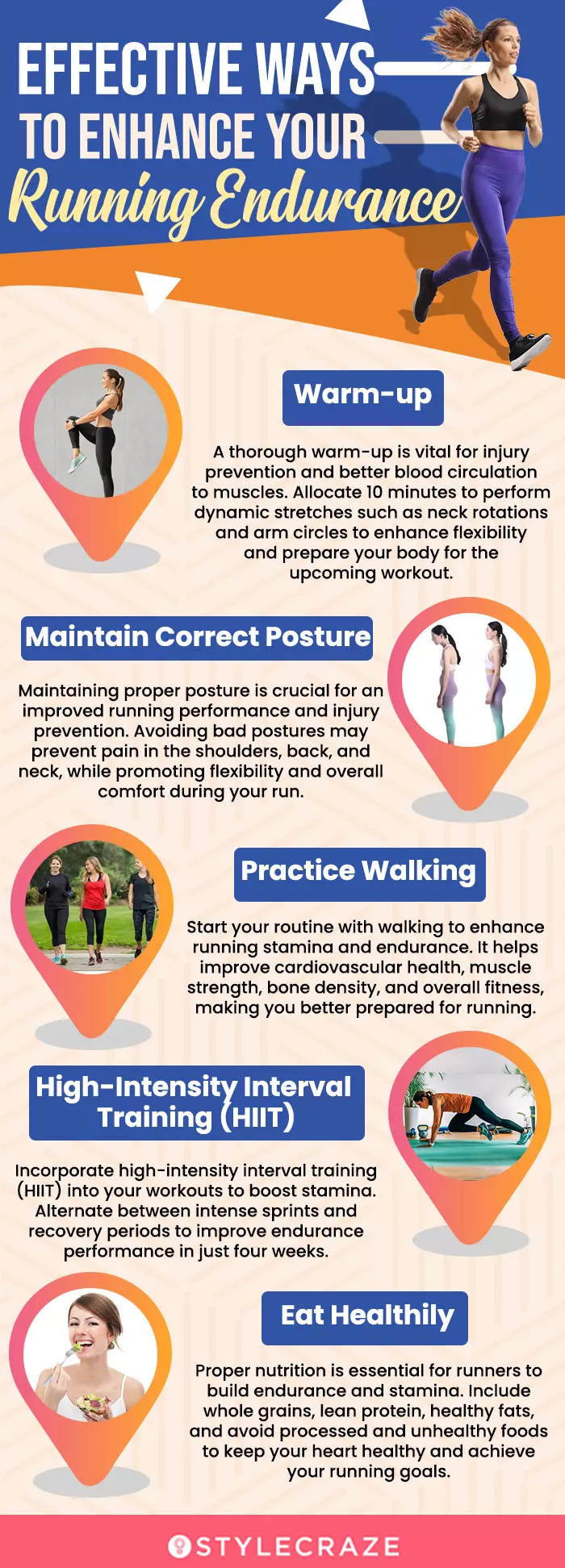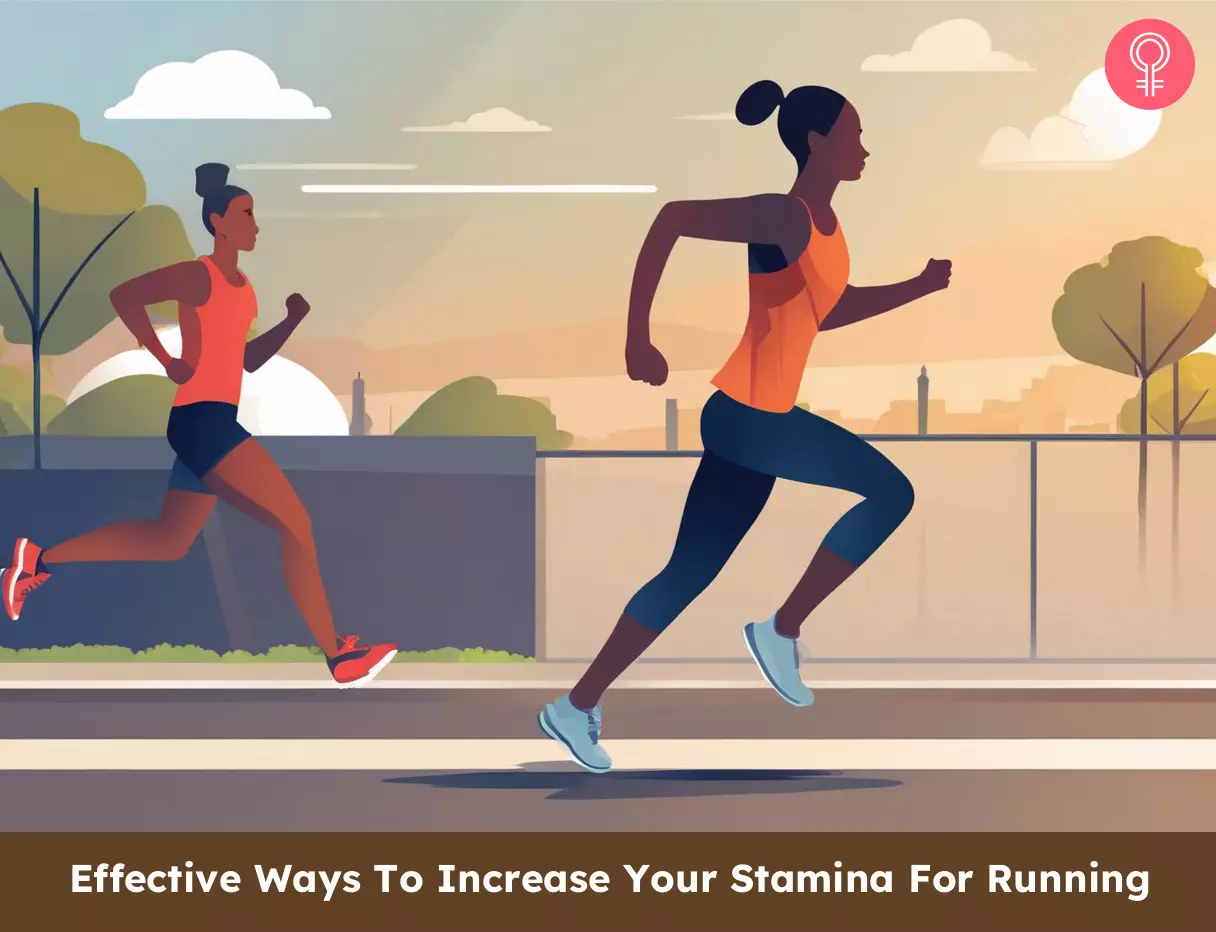How To Increase Running Stamina – 21 Tips You Can Follow
It's time you run like the wind until you reach all your fitness goals.

Image: Shutterstock
Running requires muscle power and willpower. If you are preparing for running a marathon, you must increase your stamina for running because slow-paced long-distance running is not easy. To prepare for better marathon training, focus on your muscles, bones, lungs, and brain to successfully get to the finish line. But how to increase stamina for running? Read on to know the 20 best ways to build your running stamina and boost muscle endurance. Regular practice will enable you to run longer distances and increase your lung capacity. Scroll down!
In This Article
Why Is Running Stamina Important?
Stamina refers to the maximum physical effort you put into a task. Improving your running stamina can help you practice long-distance or endurance running with ease, which has numerous benefits. According to the Springer Sports Medicine Journal, endurance running for one year may help reduce body fat and weight as well as resting heart rate and bad cholesterol levels in physically inactive adults. This, for obvious reasons, may benefit your heart health (1). Another study found that endurance running could also have a positive impact on your mental health and benefit those with depression and anxiety disorders (2).
Increasing your running stamina requires consistent effort. The following section contains a host of tips you can follow to improve your running stamina. Scroll down.
21 Tips To Improve Running Stamina
“How to increase stamina?” is a common question asked by many people, and the solution involves gradually increasing workout intensity, including a balanced diet, and staying hydrated. Here are some tips to improve your stamina for running.
1. Warm-Up

Warm-up is necessary to increase muscle temperature and improve blood flow to prevent injury (3).
Stretching exercises increase joint movement and flexibility. A study published in The Journal of Orthopaedic and Sports Medical Therapy suggests that static stretching and dynamic range of motion (DROM) increase the flexibility of the hamstring muscles (4).
Give yourself a good 10 minutes to warm up the muscles so that they are ready to take on the challenge.
Do quick standing stretching routines like neck rotations, arm circles, shoulder rotations, waist rotations, side lunges, spot jogging, jumping jacks, side bends, and ankle rotations.
2. Maintain Proper Posture
Maintaining proper posture will help you run better and for a longer duration. It will also protect you from injury.
Improper or bad postures may cause injury, hamper flexibility, and lead to shoulder, back, and neck pain (5).
Roll your shoulders back, look ahead, push your chest up, loosen your neck and arms, clench your fist, put your thumbs inside the hollow made by the four fingers, and start running slowly. If you want to know more about it, go through this post on running tips.
3. Check Your Breathing Techniques
Concentrate on your breathing techniques to improve running stamina.
Breathing in more oxygen and breathing out more carbon dioxide is important to make your muscles work hard. Your breathing needs to increase from 15 times a minute while resting to 40-60 times a minute during exercise to meet the extra demand (6).
Inhale slowly from your nose and calculate how many steps you are taking. Do the same when you exhale slowly. Try to maintain the breathing and keep your steps steady for a long time.
4. Slow, But Steady
When it comes to increasing your running time and running endurance, you must be patient.
Aim for increasing the distance by 10%. For example, if you cover a mile this week, you must try to run 10% more the next week. And by the end of the week, you must reach the target.
Setting a target will keep you focused, and increasing the distance gradually will help increase your lung capacity.
5. Practice Walking

Walking builds endurance. One should start walking every day to improve running stamina and running endurance.
Walking and running both involve the same muscles and strengthen specific muscle groups, which builds stamina and makes you ready for running.
As a beginner runner, you should start with walking to improve cardiovascular health, increase lung capacity, muscle strength, and endurance, strengthen your bones, and improve posture and balance (7).
Include at least 30 minutes of walking in your running routine.
A study conducted on 29,742 participants found that of those with no CVD or not being at risk, 66.6% reported engaging in walking activities. This percentage decreased to 63.0% for individuals at risk with overweight or obesity and one additional risk factor, further decreased to 59.5% for those with two risk factors, 53.6% for those with three risk factors, and 50.2% for individuals with CVD.
6. Target Long Runs
It is very important to target long runs to build stamina and endurance. You can either run for 5-10 minutes at a stretch or aim to cover 800-1600 m, to begin with.
Start with slow runs at a slow pace to cover long distances instead of finishing it quickly. High pace hard runs exhaust your stamina initially.
Studies show that ultramarathon runners are more susceptible to injuries and medical issues than slow runners (8). Hence, go slow and steady and focus on the distance covered in time to build your muscle endurance.
7. Interval Runs
This interval workout is a great way to build running stamina. All you have to do is run and walk at equal intervals (run 1 min and walk 2 min or run 2 min and walk 2 min).
Alternate fast and slow running help to train muscle groups to work efficiently at a higher speed. This way, you will you able to cover long distances without feeling worn out.
A study published in the Journal of Strength and Conditioning Research showed that six sessions of sprint interval training improved both running endurance and running performance in athletes (9).
Incorporate interval workout training into your running routine to build stamina.
 Quick Tip
Quick Tip8. Tempo Runs
The tempo run is effective in building stamina and running endurance. Tempo runs cover shorter distances but at a higher pace. These intense, short runs help to clear lactic acid from the muscles, which enhances your capacity to run long without physical fatigue.
Tempo runs may not be effective in building your breathing capacity but can help clear lactic acid (10). Practice three different tempo runs, i.e., short tempos, mid-tempos, and long tempos, which can help improve your pace.
9. Run On An Incline

Various factors can prevent you from running with ease – and one of them is a road that is slightly inclined. Start practicing inclined running on a treadmill and then on the road to improve your endurance and stamina.
Running on an incline will also help build strength in your calves, quads, and hamstrings. This, in turn, can improve your endurance and the ability to run faster on a less inclined plane (11).
10. Be Consistent, Practice Running
Consistency is important for any sport. Practice running at least three times a week, along with other exercise regimens. This will help build stamina and enhance motivation and running endurance.
A blogger details how he was gradually able to increase his running stamina with practice. Consistency is key. After 2 years of practice, he was able to clock a 10 km run with ease: “I was able to do a full 10 km round without a gradual increase [in distance] as was needed from [when I was trying to cover] 1 km to 5 km. This surprised me (i).”
11. Land Softly
When you start running, do not stamp your feet on the ground. It will hurt your knees and make running difficult. Land softly on your heels and wear shoes that will support your feet.
12. Incorporate Cross-Training
Cross-training lets you work on different sports or activities besides running, such as swimming, cycling, or rowing. These exercises can increase overall stamina while reducing the chance of injury and improving cardiovascular fitness by providing your running muscles some rest.
13. High-Intensity Interval Training (HIIT)
In addition to hitting the road or the treadmill, you must incorporate HIIT into your workout routine. Interval training is a technique to improve stamina, endurance, and speed. It involves alternating the running pace and style.
For example, in sprint workouts, sprint as fast as you can for 30 seconds, and then slow down and run at the same speed for 2 minutes. Studies showed that four weeks of HIIT helped improve endurance performance (12).
14. Strength Training
Strength training is important to tone the muscles and build muscle mass. Focus on building the leg muscles and glutes, which can help in building running endurance.
Practice strength training activities like lifting weights, resistance band exercises, and bodyweight exercises like lifting or moving objects, etc. They will tone and build your muscles and make them stronger.
15. Plyometrics

Plyometric exercises must be a part of your training. All athletes train their cardiovascular system to improve their oxygen consumption by incorporating explosive exercises in their workouts.
Explosive exercises or plyometrics, like burpees, squat jumps, jumping lunges, and froggy jumps, not only improve oxygen consumption but also build muscle power (13).
16. Proper Stretching To Cool Down Muscles
After you are done running for the day, you must stretch or cool off. It is as important as warming up.
Active cooldown is important to prevent injuries, accelerate recovery of lactate in the blood, and provide relief to sore muscles (14).
Give your arms, palms, feet, calves, hamstrings, lower back, upper back, neck, and shoulders a good stretch. It will prevent your muscles from becoming stiff.
17. Listen To Music
Music can be a great source of motivation when it comes to running or working out in general.
Rhythmic and motivational songs will keep you going and enable you to exercise for a longer time (15). If you can match the running pace with the beats, even better!
18. Eat Healthily

Runners need to eat. Focussing on energy-giving foods to boost stamina is crucial. If you don’t include the major and required food groups in your diet, you will not be able to build muscle endurance and stamina.
You must consume whole grains, starchy vegetables, lean protein, healthy fats, and nuts (16). Additionally, avoid energy drinks, packaged fruit or vegetable juices, fatty and sugary foods, and fried foods.
You need to keep your heart healthy to be able to see results. Consuming junk will not help. Instead, eating healthy will help you reach your goal quicker.
19. Hydrate Yourself
Hydration is another important factor that affects both physical and mental performance. Drinking enough water after exercising prevents dehydration and improves performance (17).
20. Choose A Good Pair Of Running Shoes
Wear a comfortable pair of running shoes to improve your performance. These may not directly improve your running stamina, but they can affect your performance. If your running shoes are not good, they can not only lead to injury but also interfere with how much, how long, and how well you can run.
 Quick Tip
Quick Tip21. Rest
It is important to let your body rest so that the sore muscles get time to heal and repair themselves. Get at least 7 hours of restorative sleep every day. Also, do not go running every day. Mix it up with other kinds of workouts.
While increasing running stamina is essential to endurance, you should understand the value of recovery to aid long-term performance and prevent injuries. Scroll down to know more.
Importance Of Recovery
Recovery is essential to increase your running stamina. Proper recovery supports muscle growth and healing while preventing injuries and strain on your muscles. Use recovery techniques like foam rolling, light stretching, and getting enough sleep. Consider combining active recovery days with low-impact exercises, like yoga or walking, to encourage blood flow and muscle repair.
Infographic: Effective Ways To Enhance Your Running Endurance
If you are looking to increase your running endurance and go the extra mile, there are several effective strategies to consider. By incorporating these techniques into your training routine and lifestyle, you can gradually build up your stamina, improve your overall performance, and reach new running milestones. Whether you are a beginner or a seasoned runner, these tips will help you enhance your running endurance and achieve your fitness goals. Take a look at the infographic below to learn more!

Illustration: StyleCraze Design Team
It takes a lot to improve your stamina for running, but you can do it successfully if you have that dedication and mental strength. A proper posture, good breathing technique, regular walking, running on an incline, high-intensity interval training (such as tabata workouts and VO2 max workouts) and strength exercises, and proper hydration contribute to building your stamina over a period of time. Remember, your running should be preceded by 10 minutes of warm-up exercises, while you should end the session with cooling exercises like stretching. In addition to strength and endurance training, it is also important to prioritize muscle recovery and injury prevention when training for increased stamina in running. One effective method for aiding in muscle recovery and preventing injury is foam rolling. Also, focus on your nutritional planning and get enough sleep. Be consistent and focus on your goals, and you will eventually see your stamina improve in a few weeks.
Frequently Asked Questions
What role does strength training play in increasing running stamina?
Strength training increases muscular endurance and power, essential for increasing running stamina. Exercises like lunges, deadlifts, and squats help you develop the muscle strength required for long-term running performance.
Which juice is good for stamina?
There is no specific juice to build your stamina. Drink any fruit or vegetable juices to stock up on vitamins and minerals for energy.
Is milk good for stamina?
Organic milk is good to build stamina. But make sure to check with your nutritionist before drinking milk.
What should you eat before a run?
Before going on a run, you should load yourself with carbohydrates and good fats for an easy supply of glucose to give you energy for running.
What food should runners avoid?
Runners should avoid junk and processed foods. Saturated and trans fats increase body weight, which decreases performance.
Should I run every day?
Practice running three times a week, along with strength training, HIIT, and rest.
How long does it take to build running stamina?
It is estimated that running thrice a week along with adequate resting time may see a significant increase in stamina in 2-3 months. Staying consistent for a period of 6 months may help you reach your peak performance (18).
How can I increase my stamina in 2 days?
Unfortunately, you cannot increase your stamina in 2 days. Building stamina is a gradual process that requires commitment and consistency for an extended period to get visible results.
Key Takeaways
- Before a run, a 10-minute warm-up that includes stretching can make one fitter for performance.
- Running time and distance should be gradually increased as one builds stamina to avoid unwanted injuries.
- Running on an incline on a treadmill can build one’s endurance.
- A balanced diet rich in proteins, carbs and healthy fats can improve stamina.
Illustration: Effective Ways To Increase Your Stamina For Running

Image: Stable Diffusion/StyleCraze Design Team
Ready to take your running to the next level? Click on this video to discover three powerful workouts that will boost your stamina and help you conquer those extra miles.
Personal Experience: Source
StyleCraze's articles are interwoven with authentic personal narratives that provide depth and resonance to our content. Below are the sources of the personal accounts referenced in this article.
i. How To Train Ourself To Run 10km? How Much Effort Is Required? Here’s My Experiencehttps://thoughtsthathavemass.wordpress.com/2019/08/16/how-to-run-a-10k-marathon-fitness-running-health-workout/
References
Articles on StyleCraze are backed by verified information from peer-reviewed and academic research papers, reputed organizations, research institutions, and medical associations to ensure accuracy and relevance. Read our editorial policy to learn more.
- Meta-analyses of the effects of habitual running on indices of health in physically inactive adults, US National Library of Medicine, National Institutes of Health.
https://www.ncbi.nlm.nih.gov/pmc/articles/PMC4579257/ - A scoping review of the relationship between running and mental health, US National Library of Medicine, National Institutes of Health.
https://www.ncbi.nlm.nih.gov/pmc/articles/PMC7663387/ - The effect of warm-ups with stretching on the isokinetic moments of collegiate men, Journal of Exercise Rehabilitation, US National Library of Medicine, National Institutes of Health.
https://www.ncbi.nlm.nih.gov/pmc/articles/PMC5833972/?report=classic - The effect of static stretch and dynamic range of motion training on the flexibility of the hamstring muscles, The Journal of Orthopaedic and Sports Physical Therapy, US National Library of Medicine, National Institutes of Health.
https://pubmed.ncbi.nlm.nih.gov/9549713/ - Guide to Good Posture, US National Library of Medicine, National Institutes of Health.
https://medlineplus.gov/guidetogoodposture.html - Your lungs and exercise, Breathe, US National Library of Medicine, National Institutes of Health.
https://www.ncbi.nlm.nih.gov/pmc/articles/PMC4818249/?report=classic - Walking to Health, Sports Medicine, US National Library of Medicine, National Institutes of Health.
https://pubmed.ncbi.nlm.nih.gov/9181668/ - Health and exercise-related medical issues among 1,212 ultramarathon runners: baseline findings from the Ultrarunners Longitudinal TRAcking (ULTRA) Study, PLOS One, US National Library of Medicine, National Institutes of Health.
https://pubmed.ncbi.nlm.nih.gov/24416176/ - Six Sessions of Sprint Interval Training Improves Running Performance in Trained Athletes, Journal of Strength and Conditioning Research, US National Library of Medicine, National Institutes of Health.
https://www.ncbi.nlm.nih.gov/pmc/articles/PMC5839711/ - Response of ventilatory and lactate thresholds to continuous and interval training, Journal of Applied Physiology, US National Library of Medicine, National Institutes of Health.
https://pubmed.ncbi.nlm.nih.gov/3988668/ - The effects of incline and level-grade high-intensity interval treadmill training on running economy and muscle power in well-trained distance runners, Journal of Strength and Conditioning Research, US National Library of Medicine, National Institutes of Health.
https://pubmed.ncbi.nlm.nih.gov/24172721/ - Effects of a 4-week high-intensity interval training on pacing during 5-km running trial, Brazilian Journal of Medical and Biological Research, US National Library of Medicine, National Institutes of Health.
https://www.ncbi.nlm.nih.gov/pmc/articles/PMC5649866/?report=classic - CURRENT CONCEPTS OF PLYOMETRIC EXERCISE, International Journal of Sports Physical Therapy, US National Library of Medicine, National Institutes of Health.
https://www.ncbi.nlm.nih.gov/pmc/articles/PMC4637913/ - Do We Need a Cool-Down After Exercise? A Narrative Review of the Psychophysiological Effects and the Effects on Performance, Injuries and the Long-Term Adaptive Response, Sports Medicine, US National Library of Medicine, National Institutes of Health.
https://www.ncbi.nlm.nih.gov/pmc/articles/PMC5999142/ - Effect of music tempo on exercise performance and heart rate among young adults, International Journal of Physiology, Pathophysiology and Pharmacology, US National Library of Medicine, National Institutes of Health.
https://www.ncbi.nlm.nih.gov/pmc/articles/PMC5435671/ - Role of nutrition in performance enhancement and post exercise recovery, Journal of Sports Medicine, US National Library of Medicine, National Institutes of Health.
https://www.ncbi.nlm.nih.gov/pmc/articles/PMC4540168/ - Investigating the associations between hydration and exercise performance: methodology and limitations, Nutrition Reviews, US National Library of Medicine, National Institutes of Health.
https://pubmed.ncbi.nlm.nih.gov/23121347/ - Time course of changes in endurance capacity: a 1-yr training study, Medicine & Science in Sports & Exercise, PubMed
https://pubmed.ncbi.nlm.nih.gov/19346973/
Read full bio of Kristen Arnold
Read full bio of Priyanka Sadhukhan
Read full bio of Arshiya Syeda
Read full bio of Himanshi Mahajan


























Community Experiences
Join the conversation and become a part of our empowering community! Share your stories, experiences, and insights to connect with other beauty, lifestyle, and health enthusiasts.